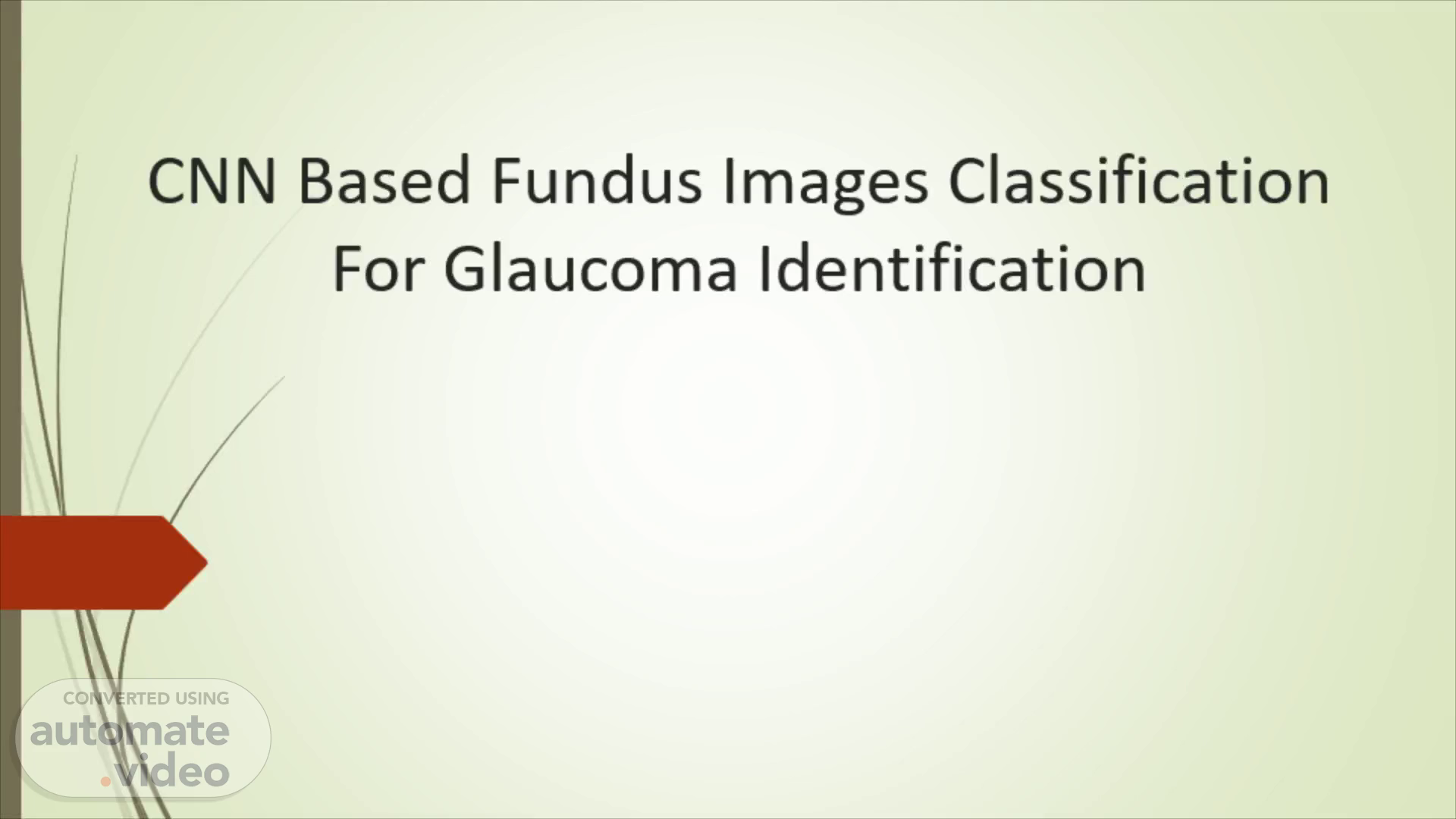
CNN Based Fundus Images Classification For Glaucoma Identification
Scene 1 (0s)
CNN Based Fundus Images Classification For Glaucoma Identification.
Scene 2 (27s)
CNN Based Fundus Images Classification For Glaucoma Identification.
Scene 3 (44s)
Glaucoma is on the rise!!!. Source: The World Glaucoma Association, 2020.
Scene 4 (1m 10s)
Introduction. Healthy eyes vision loss due to glaucoma.
Scene 5 (1m 44s)
Motivation. Computational models can be used as a second opinion in the glaucoma diagnosis process. Address the issue due to misdiagnosis Better classification with fundus images.
Scene 6 (2m 4s)
Objectives. Explore literature related to deep learning and computer vision techniques for retinal fundus images Design and develop a Convolution based fundus images classification to support glaucoma diagnosis process Analyse the accuracy of the classification results.
Scene 7 (2m 30s)
Related Studies. Study Dataset DL model Performance Accuracy Specificity Sensitivity AUC (Diaz‑Pinto et al, 2019) Fundus VGG16 89% 88% 90% 0.96 (Syna et al, 2020) Fundus DeepLabv3+ and MobileNet 97.37% - - 1 (Diego et al., 2021) Fundus CNN 94.60% 92.50% 94.57% - ( Rehman et al., 2021) Fundus VGG16, VGG19 97.8% (Khalil et al, 2018) OCT Scans Used ML technique 90% 95% 87% -.
Scene 8 (3m 4s)
Explore Explore existing literature, techniques and data sets as well. Preprocessing Apply the data preprocessing techniques to remove unwanted noises. Employ data augmentation techniques to reduce the chance of overfitting and to improve the generalization of the algorithm. Classification Develop a DL method to classify with different data namely fundus images into group of similar details. Analyze the normal and glaucoma eye using classifying data with best performances. Analyze.
Scene 9 (3m 55s)
Data Fundus Images. Pre-processing (Fundus Images) Dilation CLAHE.
Scene 10 (5m 18s)
RIM-ONE dataset https://medimrg.webs.ull.es/ ACRIMA Dataset https://figshare.com/s/c2d31f850af14c5b5232.
Scene 11 (5m 39s)
Implementation. Modified Inception v3 architecture We utilized the Keras API's Inception v3 model, which was pre-trained on the ImageNet dataset. For the method of glaucoma diagnosis, additional layers were applied instead of the model's top dense layers. The Global Average Pooling Layer was placed after the Inception v3 model to reduce the parameters, followed by the Dense Layer (512) , and lastly added the Softmax Layer ..
Scene 12 (6m 15s)
2. Modified VGG19 architecture In this study, pre-trained VGG19 was fine-tuned. The Global Average Pooling Layer is followed by the last three newly added layers Dropout Layer with 0.5 rate, Dense Layer (256) with ReLU activation function, and finally, Softmax Layer with two outputs..
Scene 13 (6m 43s)
3. Modified ResNet50 architecture In this, pre-trained ResNet50 was fine-tuned. The last two layers (Fully Connected and Softmax) were altered first. The Global Average Pooling Layer is followed by the Dropout Layer with 0.5 rate , Dense Layer (256) with ReLU activation function, and finally, Softmax Layer with two outputs..
Scene 14 (7m 13s)
Global Average Pooling Layer Reduce the number of parameters and the amount of computation performed in network. Dense Layer To classify the fundus image, the feature map of the final average pooling layer is converted into a one-dimensional vector and linked to one or more fully connected layers known as dense layers. Dropout Layer Drop-out layers aid in the prevention of overfitting as well as the speeding up of the training process. Softmax Layer The Softmax layer acts as an activation function, determining the probability of each class and classifying the target images..
Scene 15 (7m 53s)
Results of Inception-v3 architecture on (a) RIM-ONE (b) ACRIMA.
Scene 16 (8m 56s)
2 . Results of VGG19 architecture on (a) RIM-ONE (b) ACRIMA.
Scene 17 (9m 25s)
3. Results of ResNet50 architecture on (a) RIM-ONE (b) ACRIMA.
Scene 18 (9m 48s)
Summary of Results. 18. PERFORMANCE OF CNN ARCHITECTURES ON RIM-ONE CNN Architectures Performance Accuracy Precision Recall Fl score Sensitivity Specificity Loss AUC Inception-v3 96.56% 97.22% 98.31% 97.76% 98.31% 90.90% 0.0601 0.98 VGG19 94.95% 95.37% 97.98% 96.65% 97.98% 86.13% 0.0792 0.95 ResNet50 95.49% 96.50% 97.59% 97.04% 97.59 C/o 8888% 0.0689 0.97.
Scene 19 (11m 10s)
19. Comparison With The Existing S tudies.
Scene 20 (13m 9s)
20. Future Work. Develop as Ensemble model Deploy as a tool with interactive interfaces Experiment with other possible deep learning techniques Deploy in a clinical practice as a prototype and do a user study.
Scene 21 (14m 3s)
Conclusion. This paper presented deep learning approaches to classify fundus images and we’ve proposed three fine-tuned architectures based on Inception-v3, VGG19, and ResNet50 to classify glaucoma and normal images. We have applied dilation and augmentation during data pre-processing. 5-fold cross-validation based results showed that Inception-v3 predicts glaucoma with an accuracy of 98.52% among the other convolutional neural networks architectures..
Scene 22 (15m 3s)
Q/A Thank you !. 22.